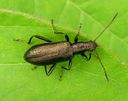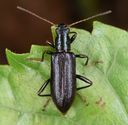Lagriini
Lagriini
Classification
- Phylum: Arthropoda
- Subphylum: Hexapoda
- Class: Insecta
- Order: Coleoptera
- Suborder: Polyphaga
- Superfamily: Tenebrionoidea
- Family: Tenebrionidae
- Subfamily: Lagriinae
- Tribe: Lagriini
Pronunciation
How to pronounce Lagriini: /læˈɡriːiːnaɪ/
These audio files are automatically generated. While they are not always 100% accurate, they are a good starting point.
Images




Summary
Lagriini is a tribe of long-jointed beetles within the subfamily Lagriinae of the family Tenebrionidae. This tribe includes a small number of species locally, while being more diverse globally. Their larvae contribute to the breakdown of decaying plant material, making them important for ecological health.
Physical Characteristics
Adults of Lagriinae are mostly medium-sized (5-12 mm). They exhibit the typical Tenebrionidae features, including a 5-5-4 tarsal formula and antennal bases hidden by canthi. Eyes are usually deeply emarginate and may partly surround the antennal bases. The last antennal segment is either the longest or the widest segment and often sexually dimorphic. The head is as broad as the pronotum and often constricted behind the eyes, and the pronotum is generally narrower than the base of the elytra, broadest at the base with sinuate or constricted sides.
Identification Tips
Examine the tarsal formula (5-5-4), deeply emarginate eyes, and the shape of the head in relation to the pronotum. Look for the distinctive features of the last antennal segment.
Habitat
Lagriinae larvae inhabit decaying vegetation and can be found in stumps and under bark.
Distribution
18 species in 2 genera in our area, 83 genera worldwide.
Diet
Lagriinae larvae feed on decaying vegetation.
Ecosystem Role
Lagriinae play a role in the decomposition of organic matter by feeding on decaying vegetation.
Tags
- beetles
- Lagriini
- Tenebrionidae
- Lagriinae